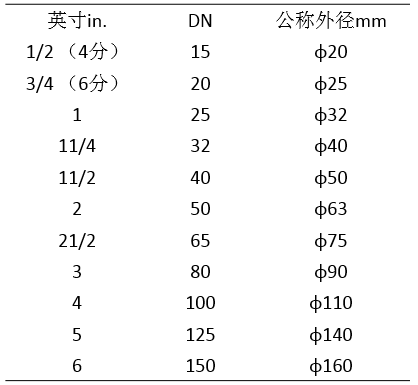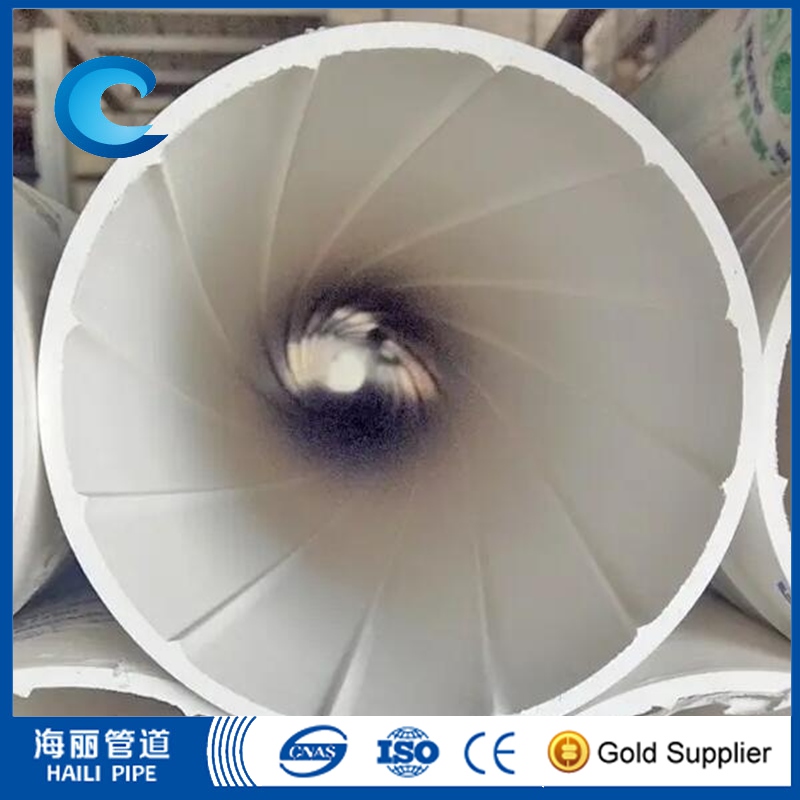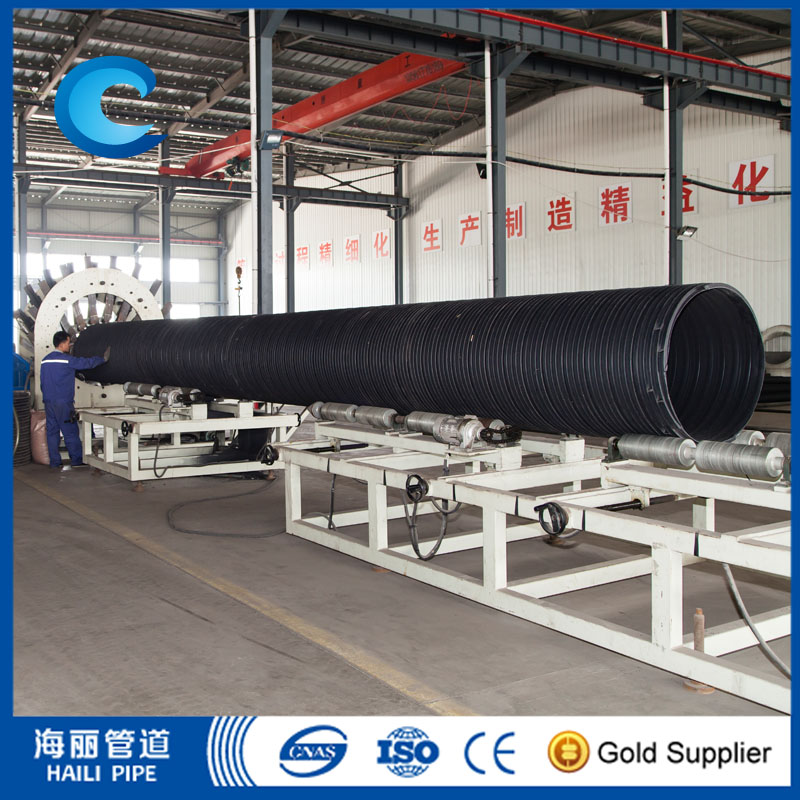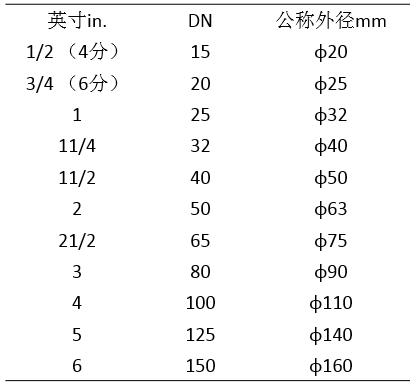Pipes are the most common material in construction electromechanical professions, with different materials and diameters, and the marking of pipe diameters is related to different types of pipes, as well as industry habits and regulations.
1. The difference between DN/De/D/Φ/PN/SDR
D: generally refers to the inner diameter of the pipe, the diameter of the inner circle of the inner wall of the pipe.
DN: refers to the nominal diameter, also known as the average outer diameter, neither the outer diameter nor the inner diameter of the pipe, but the average of the outer diameter and the inner diameter. This is a standardized diameter series for pipes and their accessories. The use of the nominal diameter is conducive to the standardization of parts and components, and is also convenient for design, manufacture, repair and management, and reduces manufacturing costs. For pipes, DN is a dimension that is less than the outside diameter and greater than the inside diameter. Corresponding to a certain nominal diameter of the pipe, its outer diameter is a certain value, and the inner diameter varies with the wall thickness. It corresponds to imperial units as follows:
NPS(normal pipe size) about DN

Φ: refers to the outer diameter of the pipe, that is, the outer diameter of the pipe including the wall thickness of the pipe. Generally, seamless steel pipes and spiral steel pipes are identified by Φ, and marked in the form of outer diameter X wall thickness. Such as: Φ108×4, it means the pipe with outer diameter of 108mm and wall thickness of 4mm.
De: refers to the outer diameter of the pipe. The outer diameter of PPR, PE pipe and polypropylene pipe is generally marked with De, and it is often marked in the form of outer diameter X wall thickness. Such as: De110 × 6.6.
We are accustomed to using DN to mark welded steel pipes, and rarely use De to mark pipes when wall thickness is not involved; but marking plastic pipes is another matter; it is still related to industry habits, in the actual construction process The pipes 20, 25, 32, etc. that we call simply refer to De, not DN.
In addition, according to the practical experience in the field:
a. The connection methods of the two pipeline materials are nothing more than: thread connection and flange connection.
b. Both galvanized steel pipes and PPR pipes can use the above two connections, but it is more convenient to use threads for pipes smaller than 50, and flanges for pipes larger than 50 are more reliable.
Comparison table of nominal diameter and outer diameter of each pipe
The relationship between DN, De, and Φ:
De is the diameter of the outer wall of the pipe; DN is the number obtained by subtracting half the thickness of the pipe wall from De; Φ is the diameter of an ordinary circle.
The respective representation ranges of De, DN, d, and ф:
De-- PPR, PE pipe, polypropylene pipe outer diameter;
DN--Nominal diameter of polyethylene (PVC) pipe, cast iron pipe, steel-plastic composite pipe, galvanized steel pipe;
d - the nominal diameter of the concrete pipe;
ф--Seamless steel pipes or non-ferrous metal pipes should be marked with "outer diameter × wall thickness".
PN: refers to the nominal pressure, which is used in the pressure representation of pipelines, pipeline fittings, valves and other shell equipment. The number followed by the letter PN does not represent the measured value, such as the PE water supply pipe of PN1.0Mpa, 1.0 represents the pressure level, and the nominal pressure refers to the working pressure of the pipe at the secondary temperature (20℃), that is, the normal working state The maximum continuous operating pressure acting on the inner wall of the pipeline. Our commonly used PE water supply pipes are divided into five pressure levels: 0.6, 0.8, 1.0, 1.25, and 1.6.
SDR: refers to the standard size ratio or standard size ratio of the pipe. The SDR on the PE water supply pipe refers to the ratio between the nominal outer diameter de of the pipe and the nominal wall thickness en, that is, SDR=de/en. It is often used in plastic pipes with outer diameter to control the size, etc. It is an important parameter to control the thickness of the pipe wall and determine the ability to withstand internal pressure. For example, the PE pipes are marked as: SDR26 PN0.6Mpa, SDR21 PN0.8Mpa, SDR17 PN1.0Mpa, SDR13.6 PN1.25Mpa, SDR11 PN1.6Mpa, etc.
2. The expression method of pipe diameter

1. The unit of pipe diameter should be mm.
2. The expression method of pipe diameter should meet the following requirements:
For water gas transmission steel pipes (galvanized or non-galvanized), cast iron pipes and other pipes, the pipe diameter should be indicated by the nominal diameter DN;
For seamless steel pipe, welded steel pipe (straight seam or spiral seam) and other pipes, the pipe diameter should be expressed by the outer diameter D × wall thickness;
For pipes such as copper pipes and thin-walled stainless steel pipes, the pipe diameter should be indicated by the nominal outer diameter Dw;
For building water supply and drainage plastic pipes, the pipe diameter should be indicated by the nominal outer diameter dn;
For reinforced concrete (or concrete) pipes, the pipe diameter should be indicated by the inner diameter d;
For pipes such as composite pipes and structural wall plastic pipes, the pipe diameter should be expressed according to the product standard method;
When the nominal diameter DN is used to represent the pipe diameter in the design, there should be a comparison table between the nominal diameter DN and the corresponding product specifications.
Characteristics and advantages and disadvantages of plastic pipes
Plastic pipe is a product made of synthetic resin and additives by melt molding. Additives include plasticizers, stabilizers, fillers, lubricants, colorants, UV absorbers, modifiers, and the like.
Commonly used plastic pipes are: rigid polyvinyl chloride pipe (PVC-U), high-density polyethylene pipe (PE-HD), cross-linked polyethylene pipe (PE-X), random copolymer polypropylene pipe (PP-R), Polybutene pipe (PB), engineering plastic acrylonitrile-butadiene-styrene copolymer (ABS), etc. The raw material composition of the plastic pipe determines the characteristics of the plastic pipe.
1) The main advantages of plastic pipes
Good chemical stability, not affected by environmental factors and medium components in the pipeline, and good corrosion resistance.
Small thermal conductivity, low thermal conductivity, thermal insulation, and good energy-saving effect.
Good hydraulic performance, smooth inner wall of the pipe, small resistance coefficient, not easy to foul, the flow area in the pipe does not change with time, and the probability of pipe blockage is small.
Compared with metal pipes, the density is small, the material is light, the transportation and installation are convenient, and the maintenance is easy.
It can be bent naturally or has cold bending performance, and can be supplied by coiled pipe to reduce the number of pipe joints.
2) The main disadvantage of plastic pipes
Poor mechanical properties, poor impact resistance, poor rigidity, and poor straightness, so the density of pipe clamps and hangers is high.
Poor flame retardancy, most plastic products are flammable, and thermally decompose when burning, releasing toxic gases and fumes.
The thermal expansion coefficient is large, and the expansion and contraction compensation must be emphasized.
3) Performance impact of plastic pipes
The mechanical properties of PVC-U, PP, and ABS are relatively high, and are regarded as "rigid pipes", which are better for surface installation. Conversely, PE, PE-X, PB are suitable for concealed application as "flexible pipes".
The use temperature and heat resistance of plastic pipes determine that PVC-U, PE, ABS can only be used for cold water pipes, while PE-X, PP, PB can be used as hot water pipes. When the building has a hot water supply system and the hot and cold water uses a unified pipe, the heat resistance becomes the main indicator.
Because of the high thermal expansion coefficient of plastic pipes, there are many thermal compensation measures such as flexible joints, expansion joints or various bending positions in plastic pipes, especially as hot water pipes. Among them, polyolefins such as PE and PP are the most popular. If not enough attention is paid to this during construction and installation, and corresponding technical measures are taken, the problem of pulling off of the expansion joint at the interface is very likely to occur.
Due to the low thermal conductivity, the plastic pipe has excellent thermal insulation performance, which can reduce the thickness of the thermal insulation layer or even eliminate the need for thermal insulation. When comparing the thermal insulation between different plastic pipes, in addition to the thermal conductivity, it is also related to their respective pipe wall thicknesses.
PE composite pipe

Composite pipes include lead-lined pipes, rubber-lined pipes, and glass steel pipes. Most of the composite pipes are composed of a working layer (requires water corrosion resistance), a support layer, and a protective layer (requires corrosion resistance).
The composite pipe is generally made of metal, and the lining is mainly epoxy resin and cement. It is characterized by light weight, smooth inner wall, low resistance, and good corrosion resistance; it is also supported by high-strength soft metal instead of metal pipe. On both sides, such as aluminum-plastic composite pipe, its characteristic is that the inner wall of the pipe will not corrode and scale to ensure water quality; there are also metal pipes on the inside and non-metal pipes on the outside, such as plastic-clad copper pipes, which are made of plastic Poor thermal conductivity plays a role in thermal insulation and protection.
According to the metal material, it can be divided into: steel-plastic composite pipe, stainless steel-plastic composite pipe, plastic-coated stainless steel pipe, plastic-coated copper pipe, aluminum-plastic composite pipe, cross-linked aluminum-plastic composite pipe, plastic-lined aluminum alloy pipe.
It should be said that the composite pipe is the most ideal pipe for water supply and drainage pipes with a diameter of ≥300mm. It has the advantages of high strength and rigidity of metal pipes and corrosion resistance of non-metal pipes. But it is a kind of pipe that develops slowly at present. This is because:
.The combination of two kinds of pipes is more expensive than a single pipe.
.The thermal expansion coefficients of the two materials are quite different, if the bonding is not firm and the ambient temperature and the medium temperature change more drastically, it is easy to disengage, resulting in a decrease in quality.
The connection of the composite pipe should adopt the cold working method, and the hot working method can easily cause the expansion, deformation and even melting of the lining plastic. Generally, there are thread, ferrule, clamp and other connection methods.









659.webp)
210.webp)
328.webp)

294.webp)
476.webp)


